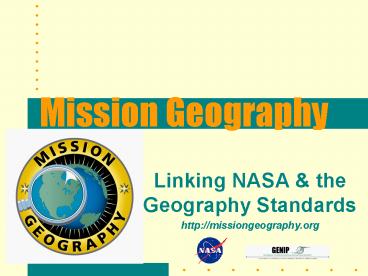Linking NASA - PowerPoint PPT Presentation
1 / 32
Title:
Linking NASA
Description:
Mission Geography Linking NASA & the Geography Standards http://missiongeography.org Workshop Introduce Mission Geography s mission Model ___ investigations ... – PowerPoint PPT presentation
Number of Views:97
Avg rating:3.0/5.0
Title: Linking NASA
1
Mission Geography
- Linking NASA the Geography Standards
- http//missiongeography.org
2
Workshop
- Introduce Mission Geographys mission
- Model ___ investigations
- Geoarchaeology (Grades 5-8)
- Physical and Human Made Features (Grades K-4)
- Volcanoes (Grades 5-8)
- ENSO (Grades 9-12)
- Introduce Mission Geography OnLine
- Your feedback
3
Geography for Life
- A vision of what geography education should be
4
A geographically informed person
- who sees meaning in the arrangement of things in
space
Can you identify London, Amsterdam, Rome,
Moscow, and Berlin?
5
(No Transcript)
6
(No Transcript)
7
A geographically informed person
- Who sees relations between
people
places
environments
8
A geographically informed person
- Who uses geographic skills
9
A geographically informed person
- And who applies spatial and ecological
perspectives to life situations.
10
NASAs Education Program Evaluation Framework
11
Mission Geography
- Curriculum support materials that link the
content, skills, and perspectives of Geography
for Life with NASAs missions and scientific
findings. - Three grade levels K-4, 5-8, 9-12,
- Available on one CD-ROM, and
- Supported by a website
- http//missiongeography.org
12
Mission Geography
- Use NASA research, data, and images
- To drive activities,
- To develop key geographic skills, e.g., pattern
recognition and map interpretation and analysis,
and - To model the work of NASA scientists and the
methods they use to conduct research.
13
Mission Geography
- Ultimate goal
- To excite and educate learners about geography,
about NASAs research and missions, and about the
world in which they live.
14
Mission Geography
- Development Process
- Using the best teachers, scientists, geographers,
NASA education specialists, and geography
educators to create meaningful activities
The Review and Critique Team Along with some of
the Writing Team
15
NSTANCTMITEAGENIP
16
Mission Geography
- Subject matter focus
- Seeing the World in Spatial Terms
- Physical Systems
- Environment and Society
17
Mission Geography
18
Mission Geography
- Module Fundamentals
- Must teach interesting and meaningful geography
- Must model geographic thinking and problem
solving - Must engage students in real world contexts and
problems.
19
Module Components
- Module Overview
- Linked to math, science, technology Standards
- Investigations
- Linked in detail to geography Standards
- Teachers Guide
- Suggested strategies, background, answers
- Student Logs and Supporting Materials
- Everything needed for the investigation
20
Review Critique Workshop
21
Field Tests and Workshops
- Field tests of revised materials by a variety of
teachers - Feedback obtained at workshops
- NCGE, NCSS, NSTA
- Summer 2001 Dissemination and professional
development workshops - Alliance teachers, science teachers, AESPers
22
Mission Geography
- Modeling activities
23
Natural Hazards
- Volcanoes Local hazard, global issue?
- NASA Detecting change in Earth systems through
monitoring signals. - What role does volcanism play in the Earth
system? - Images
- Data
Aerosols (atmosphere)
Hazard zones (lithosphere/biosphere)
24
Mission Geography Module
- Phase 1 Skill building and subject matter
mastery. - Case study of effects of volcanic eruption on
Earth system, by sphere - Investigation to clarify effects of volcanic
eruption on different subsystems - Image analysis to compare effects before/after
- Develop concepts related to areal extent of
damage buffer zone analysis
25
Mission Geography Module
- More skill building and subject matter mastery
- Case study of effects of volcanic aerosols on
Earth system through three signal sensors
photographs from Space Shuttle, TOMS, AVHRR - Profile correlate temperature and aerosol index
to determine relationship
26
(No Transcript)
27
Mission Geography Module
- Phase 3 Problem solving task.
- Problem Where is it safe to fly? Monitoring
regions with aerosol hazards - Collect TOMS data.
- Map it.
- Develop a systematic categorization of world
regions in which there is a potential hazard
from volcanic ash and other aerosols.
28
(No Transcript)
29
Before the Eruption
May 1980 Landsat Infrared
30
After the Eruption
June 1980 Landsat Infrared
31
Pumice Plain
pumice
32
Mount St Helens Today
December 1999 Landsat 7 True color































